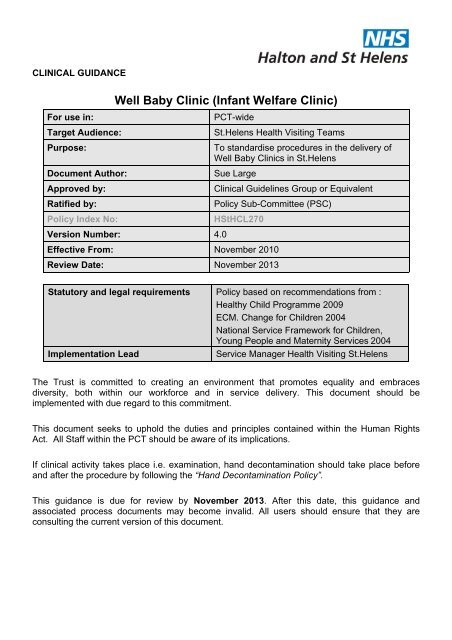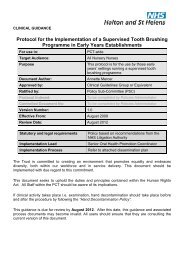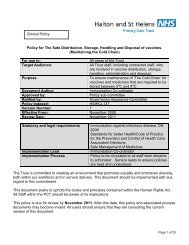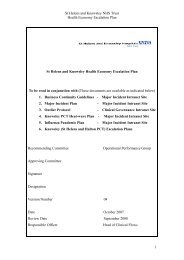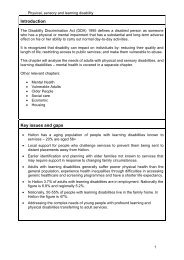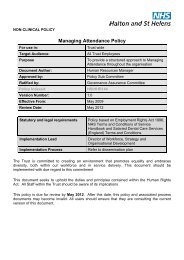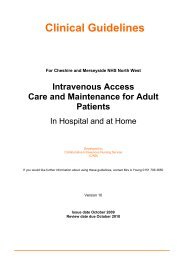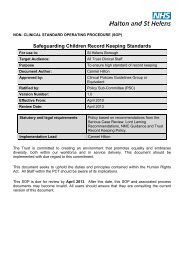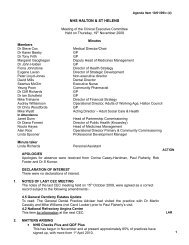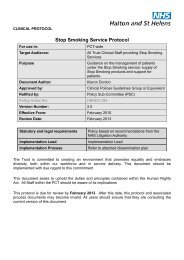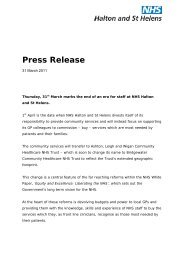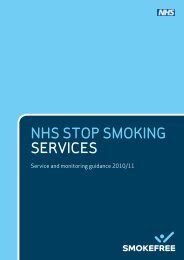CLINICAL GUIDANCE - Halton and St Helens PCT
CLINICAL GUIDANCE - Halton and St Helens PCT
CLINICAL GUIDANCE - Halton and St Helens PCT
You also want an ePaper? Increase the reach of your titles
YUMPU automatically turns print PDFs into web optimized ePapers that Google loves.
<strong>CLINICAL</strong> <strong>GUIDANCE</strong><br />
Well Baby Clinic (Infant Welfare Clinic)<br />
For use in:<br />
Target Audience:<br />
Purpose:<br />
Document Author:<br />
Approved by:<br />
Ratified by:<br />
Policy Index No:<br />
<strong>PCT</strong>-wide<br />
<strong>St</strong>.<strong>Helens</strong> Health Visiting Teams<br />
To st<strong>and</strong>ardise procedures in the delivery of<br />
Well Baby Clinics in <strong>St</strong>.<strong>Helens</strong><br />
Sue Large<br />
Clinical Guidelines Group or Equivalent<br />
Policy Sub-Committee (PSC)<br />
H<strong>St</strong>HCL270<br />
Version Number: 4.0<br />
Effective From: November 2010<br />
Review Date: November 2013<br />
<strong>St</strong>atutory <strong>and</strong> legal requirements Policy based on recommendations from :<br />
Healthy Child Programme 2009<br />
ECM. Change for Children 2004<br />
National Service Framework for Children,<br />
Young People <strong>and</strong> Maternity Services 2004<br />
Implementation Lead<br />
Service Manager Health Visiting <strong>St</strong>.<strong>Helens</strong><br />
The Trust is committed to creating an environment that promotes equality <strong>and</strong> embraces<br />
diversity, both within our workforce <strong>and</strong> in service delivery. This document should be<br />
implemented with due regard to this commitment.<br />
This document seeks to uphold the duties <strong>and</strong> principles contained within the Human Rights<br />
Act. All <strong>St</strong>aff within the <strong>PCT</strong> should be aware of its implications.<br />
If clinical activity takes place i.e. examination, h<strong>and</strong> decontamination should take place before<br />
<strong>and</strong> after the procedure by following the “H<strong>and</strong> Decontamination Policy”.<br />
This guidance is due for review by November 2013. After this date, this guidance <strong>and</strong><br />
associated process documents may become invalid. All users should ensure that they are<br />
consulting the current version of this document.
Key individuals involved in developing the document (Internal <strong>St</strong>aff Only)<br />
Name(s)<br />
Designation<br />
Janice Lawson<br />
Kath Rennison<br />
Nikki Carter<br />
Janice Halsall<br />
Family Health Coordinator<br />
Family Health Coordinator<br />
Family Health Coordinator<br />
Family Health Coordinator<br />
Distributed to the following for approvals <strong>and</strong> comments<br />
Committee(s)<br />
Members of the Policy Sub Committee (PSC)<br />
Members of the Clinical Policies Guidelines<br />
Group (CPG)<br />
Individual(s) (Include email address of external<br />
individuals (NON NHS))<br />
Designation<br />
Julie Banat<br />
Health Visitors, Community Nursery Nurses,<br />
Community Health Nurses<br />
Ann Hodgkinson<br />
Karen Worthington<br />
Health Visitors <strong>Halton</strong><br />
Service Manager Health Visiting <strong>St</strong> <strong>Helens</strong><br />
Health Visiting service <strong>St</strong>.<strong>Helens</strong><br />
Manager clerical officers<br />
Service Manager Health Visiting <strong>Halton</strong><br />
Health Visiting service <strong>Halton</strong><br />
Revision History <strong>and</strong> Version Control<br />
Revision<br />
Date<br />
Reason for Change Version No. By Who Version No.<br />
16/08/10 First Issue Sue Large Draft 1.0<br />
26.08.10 Review from consultation Draft 1.0 Sue Large Draft 2.0<br />
08.09.10 Review from admin staff Draft 2.0 Sue Large Draft 3.0<br />
02.11.10 Review from policy group Draft 3 Sue Large Draft 4.0<br />
Page 2 of 10
Table of Contents<br />
Rationale......................................................................................................................................4<br />
Audit.............................................................................................................................................5<br />
Equipment Required ....................................................................................................................6<br />
References...................................................................................................................................7<br />
Appendix 1 ...................................................................................................................................8<br />
Glossary of Terms .....................................................................................................................8<br />
Appendix 2 ...................................................................................................................................9<br />
Equality Impact Assessment Tool .............................................................................................9<br />
Appendix 3 .................................................................................................................................10<br />
Dissemination <strong>and</strong> Training Plan.............................................................................................10<br />
Page 3 of 10
RATIONALE<br />
The rationale of this protocol is to enable the Health Visiting Skill Mix Team to provide universal<br />
Well Baby Clinic services to babies <strong>and</strong> children aged 0-5 years.<br />
The aims of the clinic are:<br />
To monitor <strong>and</strong> assess a pre school child’s growth <strong>and</strong> development.<br />
To offer parental advice <strong>and</strong> support to parents/carers<br />
To offer early intervention packages of care or referral to other services /agencies<br />
These guidelines are practiced in accordance with associated Trust policies <strong>and</strong> guidelines.<br />
ACCESS<br />
The service concentrates on the health <strong>and</strong> welfare of babies who are under one year old but all<br />
pre school children can access the sessions at the following locations.<br />
Trust clinic bases <strong>and</strong> identified premises<br />
Open access with appointments for interventions<br />
GP surgeries for those babies registered with the specific GP.<br />
GP clinics operate as per individual practice preference<br />
FREQUENCY OF MEASUREMENTS<br />
When a baby is demonstrating normal growth <strong>and</strong> weight gain, it is recommended (UK-WHO<br />
growth charts 2009) that a child is weighed <strong>and</strong> measured at the following times:<br />
Weight:<br />
monthly from 2 weeks to 6 months old<br />
2 monthly up to 1 year old<br />
3 monthly older than 1 year<br />
Length/Height<br />
At developmental assessments<br />
Head circumference<br />
At new birth visit <strong>and</strong> 6 week assessment,<br />
More frequent measurements may be necessary at the discretion of the health visitor.<br />
TRAINING/COMPETENCIES<br />
All practitioners who provide Well Baby Clinic services must have the required competencies<br />
<strong>and</strong> knowledge:<br />
Child growth <strong>and</strong> measurement<br />
Plotting <strong>and</strong> recording of growth centiles (WHO growth centiles)<br />
Record keeping as per Geographical Caseload Policy 2010<br />
Nutritional requirements of the pre school child<br />
Page 4 of 10
RESPONSIBILITIES<br />
Health Visitor<br />
The health visitor will delegate functions to other team members <strong>and</strong> the most efficient use of<br />
the skill mix team is considered in providing a quality service.<br />
The Health Visitor retains overall accountability for the sessions <strong>and</strong> will locally manage staffing<br />
<strong>and</strong> resource issues pertaining to the session in liaison with the senior administrator.<br />
Health Visiting team skill mix<br />
Health Visiting team skill mix staff must ensure compliance with the m<strong>and</strong>atory <strong>and</strong> essential<br />
training requirements to fulfil their role<br />
A diary is to be maintained in clinics to identify the dates when families have been asked to<br />
return to clinic when there are stated concerns from any team member. This will provide a<br />
check system to ensure attendance <strong>and</strong> any child who does not re-attend is reported to the<br />
named health visitor for follow up. The diary is stored at the front of the clinic records box or<br />
cabinet. This diary will offer effective communication between practitioners <strong>and</strong> entries will be in<br />
accordance with st<strong>and</strong>ard guidance as detailed in the Geographical Corporate Working Policy<br />
2010.<br />
A contact sheet is completed<br />
Where there are issues/concerns that are to be reported to the health visitor.<br />
If the child’s health visitor is not based at the same venue as the well baby clinic<br />
If case management of the child does not lie within the team conducting the community<br />
baby clinic. Other practitioners who are providing clinic cover, must complete the contact<br />
sheets<br />
At all GP baby clinics<br />
The top copy of the contact sheet is retained in the clinic record card, the middle copy is sent to<br />
the named Health Visitor <strong>and</strong> the bottom copy is given to the parent/carer.<br />
Administrative <strong>St</strong>aff<br />
All Well Baby Clinic records to be filed in lockable filing cabinets.<br />
The community receptionist will receive the name of the child in attendance <strong>and</strong> give the well<br />
baby clinic record to the practitioner in attendance<br />
Clinics held in GP premises will operate as per GP practice preference<br />
AUDIT<br />
Well Baby Clinic records will be audited annually.<br />
Page 5 of 10
EQUIPMENT REQUIRED<br />
<br />
Approved paediatric weighing scale, calibrated annually. This should be placed on a<br />
safe, firm surface e.g. table at a suitable height<br />
Approved weighing scales for older children<br />
Approved length mat <strong>and</strong> height measure<br />
Approved disposable head circumference measure (lasso)<br />
H<strong>and</strong> wash facility or h<strong>and</strong> gel<br />
Baby changing mat<br />
Blue tissue roll<br />
Azo wipes<br />
Waste bin <strong>and</strong> nappy bin<br />
<strong>St</strong>ationary –<br />
Well Baby clinic record<br />
Male <strong>and</strong> female centile charts (WHO Growth chart range)<br />
Conversion chart<br />
Contact sheets<br />
Appropriate referral forms<br />
Continuation sheets<br />
ACTION<br />
RATIONALE<br />
1. On arrival, receptionist receives red<br />
book from parent/carer, identifies<br />
corresponding clinic card <strong>and</strong> h<strong>and</strong>s to<br />
practitioner GP clinics operate as per<br />
practice.<br />
2. Ensure room is a suitable temperature<br />
for the comfort of an undressed baby<br />
To identify the child<br />
To provide quality care<br />
3. Baby seen by practitioner in order of<br />
attendance/appointment<br />
4. Baby weighed naked To offer best practice<br />
5. Plot weight on growth chart In accordance with national guidelines<br />
6. Complete documentation in;<br />
Red book (CPHR)<br />
Clinic card<br />
Contact sheet as necessary<br />
7. Wipe scale pan with Azo wipe <strong>and</strong><br />
replace tissue lining<br />
8. Complete clinic diary if child asked to<br />
return<br />
To maintain record keeping<br />
To practice infection control<br />
To enable continuing care<br />
Page 6 of 10
REFERENCES<br />
UK-WHO growth charts<br />
WHO 2009<br />
Reference<br />
Healthy Child Programme 0-5 years<br />
DH 2009<br />
ECM. Change for Children<br />
DH 2004<br />
National Service Framework for Children,<br />
Young People <strong>and</strong> Maternity Services<br />
DH 2004<br />
Relevance (whole<br />
document or section,<br />
please state)<br />
Whole document<br />
Whole document<br />
Whole document<br />
Whole document<br />
Evidence<br />
Grade<br />
Professional<br />
guidelines<br />
National<br />
programme<br />
National<br />
document<br />
National<br />
document<br />
Page 7 of 10
APPENDIX 1<br />
Glossary of Terms<br />
WHO World Health Organisation<br />
Page 8 of 10
APPENDIX 2<br />
Equality Impact Assessment Tool<br />
To be completed with the corporate document when submitted to the appropriate committee for<br />
consideration, approval <strong>and</strong> ratification.<br />
1. Does the corporate document affect one group<br />
less or more favourably than another on the basis<br />
of:<br />
Yes/No<br />
Race no<br />
Ethnic origins (including gypsies <strong>and</strong> travellers) no<br />
Nationality no<br />
Gender no<br />
Culture no<br />
Religion or belief no<br />
<br />
Sexual orientation including lesbian, gay <strong>and</strong><br />
bisexual people<br />
Comments<br />
Age yes 0-5 years<br />
<br />
Disability - learning disabilities, physical disability,<br />
sensory impairment <strong>and</strong> mental health problems<br />
2. Is there any evidence that some groups are<br />
affected differently?<br />
3. If you have identified potential discrimination, are<br />
there any exceptions valid, legal <strong>and</strong>/or<br />
justifiable?<br />
4. Is the impact of the policy/guidance likely to be<br />
negative?<br />
5. If so can the impact be avoided?<br />
6. What alternative are there to achieving the<br />
policy/guidance without the impact?<br />
7. Can we reduce the impact by taking different<br />
action?<br />
no<br />
no<br />
no<br />
yes<br />
no<br />
Sessions for 0-5 year<br />
old children according to<br />
national Healthy Child<br />
Programme<br />
If you have identified a potential discriminatory impact of this corporate document, please refer it<br />
to [insert name of appropriate person], together with any suggestions as to the action required<br />
to avoid/reduce this impact. For advice in respect of answering the above questions, please<br />
contact [insert name of appropriate person <strong>and</strong> contact details].<br />
Page 9 of 10
APPENDIX 3<br />
Dissemination <strong>and</strong> Training Plan<br />
To be completed with the corporate document when submitted to the appropriate committee for<br />
consideration, approval <strong>and</strong> ratification.<br />
The status column must be given a Red, Amber or Green rating with evidence to demonstrate<br />
an action has been completed.<br />
DISSEMINATION PLAN<br />
Title of document:<br />
Well Baby Clinics<br />
Dissemination Lead: (Print name <strong>and</strong><br />
contact details)<br />
Julie Banat 01744 697573<br />
Proposed action to retrieve out-of-date<br />
copies of the document:<br />
Date finalised:<br />
Previous document already being used? no<br />
If yes, in what format <strong>and</strong> where? Electronic/Intranet<br />
Withdraw from the internet/intranet/portal<br />
To be disseminated to:<br />
Disseminated<br />
by whom?<br />
Timescale<br />
(Date)<br />
<strong>St</strong>atus<br />
R A G<br />
Paper<br />
or<br />
Electronic<br />
Comments<br />
Trust Times<br />
Team Brief<br />
Training sessions (Give Details Below)x<br />
Other (Give Details Below)<br />
Julie Banat Within 3<br />
months<br />
G<br />
electronic<br />
IMPLEMENTATION PLAN<br />
Training Timescale Owner <strong>St</strong>atus<br />
R A G<br />
Training Event (Please provide details of available training venues/dates<br />
to educate staff about this document)<br />
Training in teams facilitated by team leaders<br />
Within 3<br />
months<br />
FHC<br />
G<br />
Training Plan Lead (Please provide details of staff who will be<br />
responsible for overseeing this training)<br />
Team leaders<br />
Compliance Monitoring Timescale Owner <strong>St</strong>atus<br />
R A G<br />
<br />
Methodology to be used for monitoring/audit (please include <strong>PCT</strong><br />
Audit Proposal Form)<br />
Audit of clinic<br />
health<br />
records<br />
Team<br />
leaders<br />
Responsibilities for conducting monitoring/audit Skill mix<br />
team<br />
Frequency of monitoring/audit (e.g. annually, 6 monthly etc) annual<br />
Process for reviewing/reporting results Link meeting<br />
Denotes: Action not yet taken or deadline for action not met. Action plan to address this must be provided.<br />
Denotes: Action partially implemented.<br />
Denotes: Action complete.<br />
Page 10 of 10


